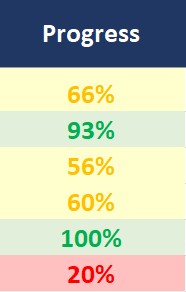So… if an Objective and Key Result exists and nobody knows about it… does it really exist? Kinda like that damn tree falling in the forest, right?
It’s absolutely critical that:
- OKRs become part of your daily work.
- You adopt a formal ritual for reviewing OKRs.
- You adopt feedback that makes sense to you.
Let’s break that down. But first, let’s outline a sample OKR that we’ll use in this article.
Objective: Achieve 50% sales growth this year through sales training and by leveraging technology.
Key Results:
- Implement SalesForce to automate lead follow-up/nurture loop, and ensure all sales staff are trained on use.
- Sales training for sales staff relevant to Widget A and Widget B.
- Implement lead generation to achieve 100 leads per month.
- Achieve a 40% increase in Widget A sales.
- Achieve a 60% increase in Widget B sales.
OKRs should become part of your daily work

The most important bit about OKRs, as the strategy bridge between vision and execution, is that they should become part of your daily work. To be specific, the Key Results outline the body of work to be accomplished in order for the Objective to be achieved. So the Key Results ought to drive a specific backlog of work items that you add to your everyday work.
If you look at the example Key Results above, it should be pretty obvious how this works. Take KR 1 – the SalesForce implementation. Remember that the Key Results themselves don’t spell out every detail of work that needs to be done, but they do identify the body of work that needs to happen. And that’s pretty clear here. It looks like we’ve got a business on our hands that needs a new implementation of SalesForce and everybody needs to be trained in how to use it.
There are some pretty clear action items to line out and add to the daily work. That’s one of the awesome parts about OKRs. In this way, OKRs are both strategic, but very, very tactical at the same time.
Adopt a formal “ritual” for OKR review

As we just saw, it’s relatively easy to blend OKRs into your daily work. That’s great because it means:
- That way OKRs actually get worked on.
- OKRs naturally get reviewed right alongside other work in the other sorts of reviews that happen.
For example, are you a software programming shop? You’ll find you’re including OKR work automatically in sprints, reviewing in stand up, retrospecting, etc. Are you a construction company? You’ll have your work alongside your daily and/or weekly project meetings. The point is whatever you do, with OKR work blended into your normal work, it’ll also get reviewed.
But don’t stop there.
Make sure you schedule a monthly ritual in which you formally review the status of your OKRs from end to end. I call this a “ritual” because its purpose is beyond simply meeting and checking the status of OKRs – anybody can do that. The process of doing this publically, celebrating well-deserved success, and of helping each other troubleshoot shortfalls and get back on track is the very process that will build the culture you ought to be looking for… A culture of teamwork, collaboration, and accountability where everyone is focused on the same things and rowing in the same direction.
![]()
Download Your FREE OKR Workbook
Get a pre-made Excel template featuring examples, explanations, and built-in calculations.
Adopt feedback that makes sense to you

One of the most confusing – and most hated-by-me – aspects of the original OKR implementation outlined and popularized by John Doerr is that “success” or “complete” for a “Key Result,” and therefore the Objectives they make up, should be calibrated at 70%. I’ll give you a moment to re-read that sentence.
So in other words, in the original implementation, on a scale of 1 to 100, 70% doesn’t mean “we’re doing pretty good” or “we’re getting pretty close to done.” No. It means, “We’ve met the goal,” or, “We’ve achieved the intended result,” or, “We’re done.” So anything past a score of 70% – like 80% – means we’ve exceeded the goal. The idea behind this is if you set 70% as the threshold of accomplishment, it encourages you to go “bigger” and accomplish more. Cool, right?
Eh… meh. Don’t worry about this. I don’t do this and I recommend you don’t bother. Just “score” your OKRs based on how complete they are. And if you want to go bigger? Easy. Set bigger and better goals and Objectives. It’s way less confusing.
If you don’t believe it’s confusing, let’s walk through two examples.
For the first example, consider Key Result #2 – sales training for all the sales staff in selling Widget A and Widget B. Either the sales team completed the training, or they didn’t. So tell me, how do you “exceed” this goal? I suppose you could game the system and add in additional training on other topics. But that’s not exceeding this Key Result. That’s adding in work related to some other as-of-yet-unnamed Key Result. Moral of the story: You’re going to run into a lot of Key Results that can’t be “exceeded.”
For the second example, look at our Key Result of achieving a 40% increase in Widget A sales. So if we’ve achieved 20% – halfway to our goal – we’d score ourselves at 50%, right? Nooo. We’d score ourselves at 35%, halfway to 70%, remember? And when we achieve a 40% increase, we’d score our Key Result at 70% – success! And if we go beyond the 40% increase to, say 50%, we’d give ourselves a score of 87.5%! Why 87.5%? Because 50-40 = 10% or 25% of 40%, and 25% of 70% is 17.5%, so to represent 50%, 70% plus 17.5% = 87.5%. Easy as… not what I want to be doing with my time.
Yeah, that was confusing as hell. Not to mention in reality the only information I personally care about is:
- How close am I to the goal? Put another way, “ARE WE THERE YET??” (Sorry… I’m in a life stage where I hear this too often,) And how much further to go?
- Did we hit the goal?
If we’ve exceeded the goal, great. But frankly, if that’s the case, I’m already moving on to new goals. So if we’re going to talk about goals we’ve exceeded, I don’t need fancy % math.
If you use my OKR Workbook, then the feedback you receive is “stoplight” color-coded, and you have the opportunity to control the thresholds. But the important part is “Complete” is 100% and anything below that is “we’re getting closer, but we’re not there yet.”
Bringing it Together
In my happy little world, “done” means 100%, we work on OKRs right alongside the rest of our work, and the process of formal review of OKRs means a chance to build and reinforce the culture that’s absolutely critical to success. Give this a try with my workbook and let me know how this works for you.
Back to Index | Next: OKR Examples
![]()
Download Your FREE OKR Workbook
Get a pre-made Excel template featuring examples, explanations, and built-in calculations.

